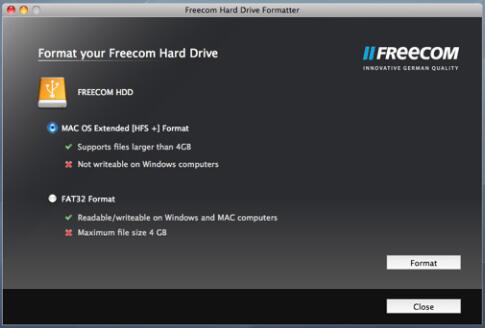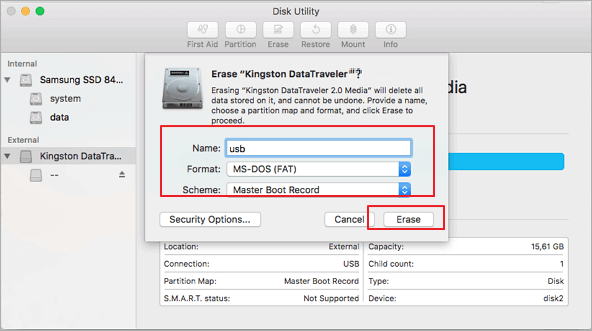4
Guide: Formatting A USB Flash Drive For Mac & PC Compatibility. Format Flash Drive For MAC And PC: It’s no surprise that PCs and Macs do not work well with each other, due to differences between the two operating systems (Windows vs. One main difference is the file system. However there is a simple solution – you can format the drive to FAT32 or exFAT that performs better than FAT32. In the resulut, your external hard drive will work just fine with Mac and Windows. You can format your external hard drive from either the PC or Mac. How to format a WD hard drive to exFAT or FAT32 file system Answer ID 291 A Western Digital external hard drive can be used on both Windows and Mac OSX. This is useful if a drive is being used under both Operating System (OS)to move files between the two environments. Most WD Drives come formatted in the NTFS (Windows) or HFS+ (Mac) format.
How to Format USB Drive for Mac & PCServer-One ↓↓
Server-Two (Direct Download) ↓↓
Server-Three
Data Recovery for Mac Fat32 formatter is provided by iSkysoft. The Fat formatter download is available on the provider website with a step by step guide for installation and use of the same. The downloading is simple and easy and the software supports formatting up to 2TB of disk space. Sony- FAT32 Formatter for Windows. Download FAT32format GUI (GUIFormat) - Seamlessly format FAT32 file system drives and partitions and avoid potential performance issues in the future using this application. Iomega Fat32 Formatter Download. Fat32 Formatter - Fat32 Formatter 1 11 - Miniaide Fat32 Formatter - Free Fat32 Formatter - Fat32 Formatter Free. MiniAide Fat32 Formatter Server Edition can perform basic to advanced partition operations on your servers without data loss, including: Resize/Move partitions, Change Cluster Size, Extend Partition, Split Partition, and Delete partitions, Format par.
/installing-mac-os-x-sierra-on-an-empty-hard-drive/. USB Format For Mac And PC To share a USB drive between a Mac and a Windows PC, there are two disk formats to choose from: exFAT and FAT32. The other formats — Microsoft’s NTFS and Apple’s Mac OS Extended — don’t work well on the other operating system. There are a few subtle differences between exFAT and FAT32, but most of these are only an issue if you are using a drive on a server. For desktops using a USB drive, there are only two differences to be concerned about. FAT32 is the older version of FAT and can’t handle file sizes larger than 4GB. ExFAT is not compatible with computers older than Windows Vista or Mac OS X 10.6.5.
Software for Windows. A NEW SMART PERSONAL CONTENT APP: Be among the first to try the EdgeRover™ desktop app! WD Backup (Support for WD Backup has ended. Users should download. Acronis True Image for Western Digital to back up their drives.) WD SmartWare (Support for WD SmartWare has ended. Users should download.
Is NTFS Compatible with Mac?
The NTFS file system is another option to use for Windows formatted drives and volumes, but it has limited compatibility with Mac OS by default. Mac users can mount and read NTFS formatted Windows drives, making NTFS compatible with the Mac on the reading and mounting front, but writing to an NTFS drive requires using either third party software or enabling NTFS write support on the Mac using an experimental functionality bundled on the Mac. This is less than ideal for most users however, so while NTFS is compatible with a Mac and Windows PC, if you want to do heavy file sharing between the two with a lot of reading and writing, you may be better off formatting a drive as FAT32 as discussed above.
What about HFS Apple File System?
HFS is the Mac file system. If you only intend on using the drive on a Mac it’s recommended to format for Mac OS X use only using the journaled file system. Just be aware that the Mac-only formats are typically not readable by Windows machines without some third party software on the PC.
Formatting With Windows 8.1
Step 1
Insert the USB drive into an open port on your Windows computer and then launch the Windows Disk Management Utility. To find it, type “disk management” or “format disk” in Windows Search and select “Create and Format Hard Disk Partitions.”
Step 2
Select your USB drive in the Volume column. In most cases, this is the D: drive. If you have several drives, you can also tell which is the USB drive by its size in the Capacity column, or by launching File Explorer and looking at the name it uses in the left menu.
Step 3
Click the “Action” menu and select “All Tasks.” Click “Format” in the drop-down menu to open the Format window.
Step 4

Click the “File System” menu and select “ExFAT.” To use the USB drive on an old computer, select “FAT32.”
Step 5
Mac Os Yosemite Format A Drive Fat32 Download
Enter a name in the Volume menu; names help to distinguish the drive if you have more than one. Clear the “Quick Format” check box if you have sensitive information on the drive that you don’t want easily recovered. Anyone with a basic recovery program can pull erased data from a drive that was formatted using the Quick Format option, and unless you use a secure deletion utility, even standard formatting is vulnerable to later data recovery. Click “OK.”
Formatting with OS X Yosemite
Step 1
Insert the USB drive into an open port on your Mac computer. Launch Disk Utility, which is located in the Utilities sub-folder inside the Applications folder. Alternatively, press “Space-Command” and type “disk utility” in Spotlight Search.
Mac Os Yosemite Format A Drive Fat32 Drive
Step 2
Select your USB drive in Disk Utility’s left menu. In OS X, you can identify the drive by its manufacturer and disk size. Click the “Erase” tab.
How To Format A Drive
Fat32 Formatter For Mac Download
Step 3

Mac Os Yosemite Format A Drive Fat32 Windows 7
Click the “Format” menu and select “ExFAT.” If you plan to use the drive with an old computer, select “MS-DOS (FAT)” instead, which is Apple’s name for “FAT32.”
Step 4
Usb Stick Fat32 Format Mac
Click the “Security Options” button if you don’t want to use a fast format. Drag the security slider from “Fastest” to “Most Secure.” As with a Windows Quick Format, data deleted with a fast erase may be recoverable by someone with basic file recovery software. Enter a name to help you identify this USB drive from others and click “Erase.” Before removing the drive, click the “Eject” button beside the USB drive in Finder, or drag its icon from the desktop onto the “Eject” button in the Dock.
Are you looking for a secure way to format USB to FAT32 on Mac? You are at the right place. Follow here, you can find two methods that will assist you in doing so on your storage device. And if you lost data during the formatting, reliable Mac file recovery software is ready to help anytime:
| Workable Solutions | Step-by-step Troubleshooting |
|---|---|
| Method 1. Use Disk Utility | Connect USB to Mac > Go to Applications > Utilities > Disk Utility > Select USB and click 'Erase'...Full steps |
| Method 2. Use Terminal Command | Connect USB to Mac > Hit cmd + space keys > Type terminal and hit Enter...Full steps |
| Bonus Tip. Recover Formatted Data | If you lost data due to formatting, run EaseUS file recovery software > Scan and recover formatted data...Full steps |
How to Format a USB Flash Drive with Mac to FAT32
Computer users who use a USB might have the demand for formatting it to the FAT32 file system. Compare with the other commonly used NTFS file system on a flash drive, FAT32 has a compatibility advantage across many operating systems.
It's a universal format that is compatible with Mac OS X/macOS, Windows, Linux, and DOS systems. So, if users anticipate using the flash drive with more than one operating system, they will definitely benefit from the FAT32 file system. For Apple Mac users, there are two ways to format a USB flash drive to FAT32, namely Disk Utility and Terminal command line. Below are the detailed steps of the FAT32 format with both methods.
Method 1. Format FAT32 on Mac [Disk Utility]
To format USB to FAT32 with Disk Utility will erase all data on the flash drive, so before you doing so, please do remember to check whether you have saved useful data to another secure device in advance.
To format the USB drive to FAT32, follow the next steps:
Step 1. Connect the USB flash drive to your Mac computer.
Step 2. Go to Applications >Utilities > Double click and open Disk Utility.
Step 3. Select your USB flash drive on the sidebar, choose Erase.
Step 4. Rename the USB flash drive (optional).
Step 5. Choose the format as MS-DOS (FAT) for Format, Master Boot Record for Scheme. Then click Erase.
Wait for the process to complete, then you'll get an empty new USB flash drive with FAT32 as the file system. You can use it for saving data again.
Method 2. Format FAT32 on Mac [Terminal Command Line]
The command-line behavior does the same way to erase data with the Disk Utility. Again, create a backup before taking this action.
To format FAT32 on Mac with Terminal, follow the next steps:
Step 1. Connect the USB flash drive to your Mac computer.
Step 2. Hit cmd + space to run Spotlight, type: terminal, and hit Enter.
Step 3. Type: diskutil list and find out which disk is your USB drive.
Step 4. Type: sudo diskutil eraseDisk FAT32 MBRFormat /dev/disk2.
- sudo gives you user right.
- Diskutil calls disk utility program.
- eraseDisk commands to format.
- FAT32 sets the file system.
- MBRFormat tells disk utility to format with a Master Boot Record.
- /dev/disk2 is the location of the USB drive.
Wait for the process to complete. After this, you can type 'diskutil list' in the command again to check if the formatting has been successful.
Bonus Tip: How to Recover Data from Formatted USB
Formatting the USB would erase the data on it completely, so please make sure that you have a backup. If you don't, you can count on data recovery software to retrieve the lost data.
Fat32 Format Utility
EaseUS Data Recovery Wizard has both Windows and Mac versions, so it's a good choice for data recovery, no matter you're using a PC or Mac. For Mac users, it only takes a few clicks for the software to scan and display the formatted data. To guarantee an effective data recovery without spending money to no avail, you can install the Mac data recovery free version for the first trial. You can preview all the found data before the final recovery.
To recover data from a formatted USB flash drive on Mac, follow the next steps:
Step 1. Correctly connect your USB flash drive to your Mac. Launch EaseUS Data Recovery Wizard for Mac. Start selecting the flash drive and click 'Scan' to let the software search lost files on it.
Step 2. After a quick scan and deep scan, all files will be presented in the left panel in the scan results.
Step 3. Select files you want to recover and click the 'Recover' button. Don't save the recoverable files to the USB drive itself in case of data overwriting.